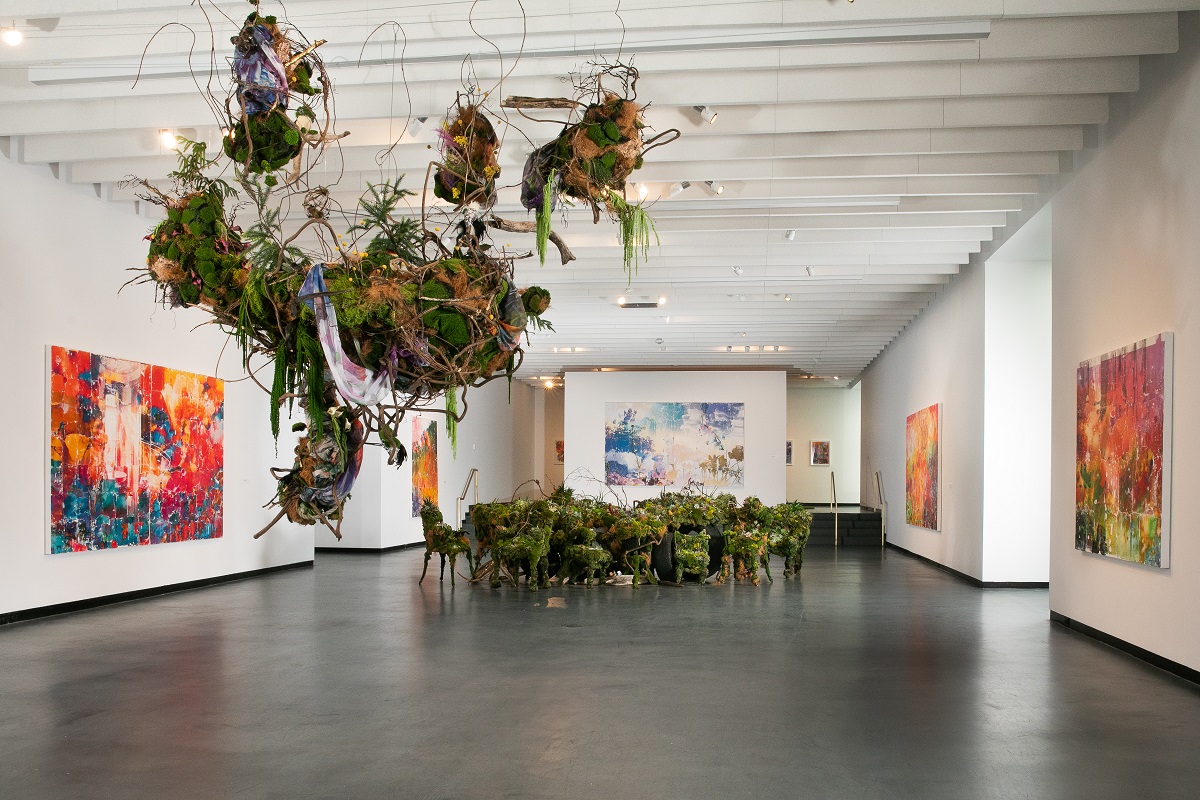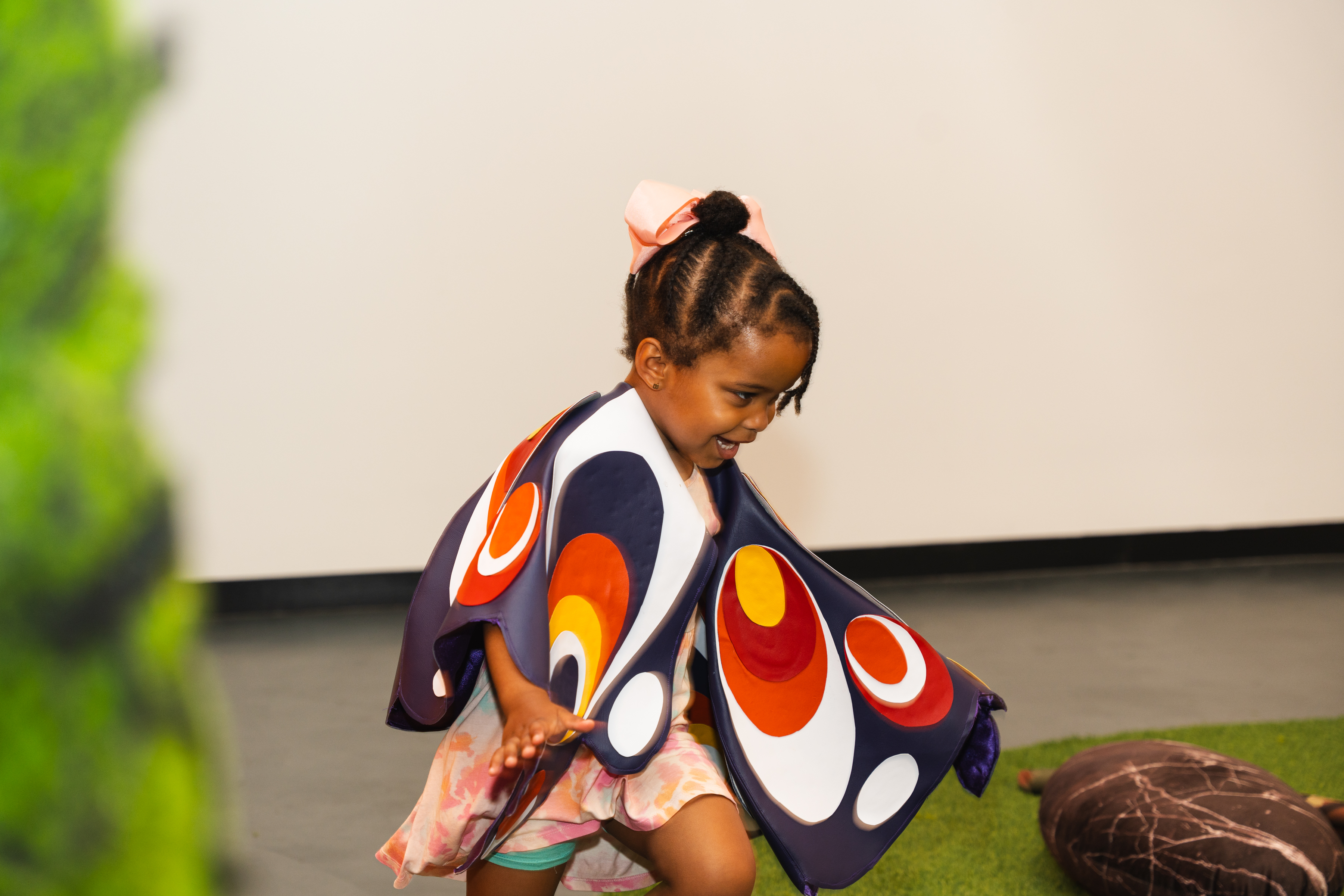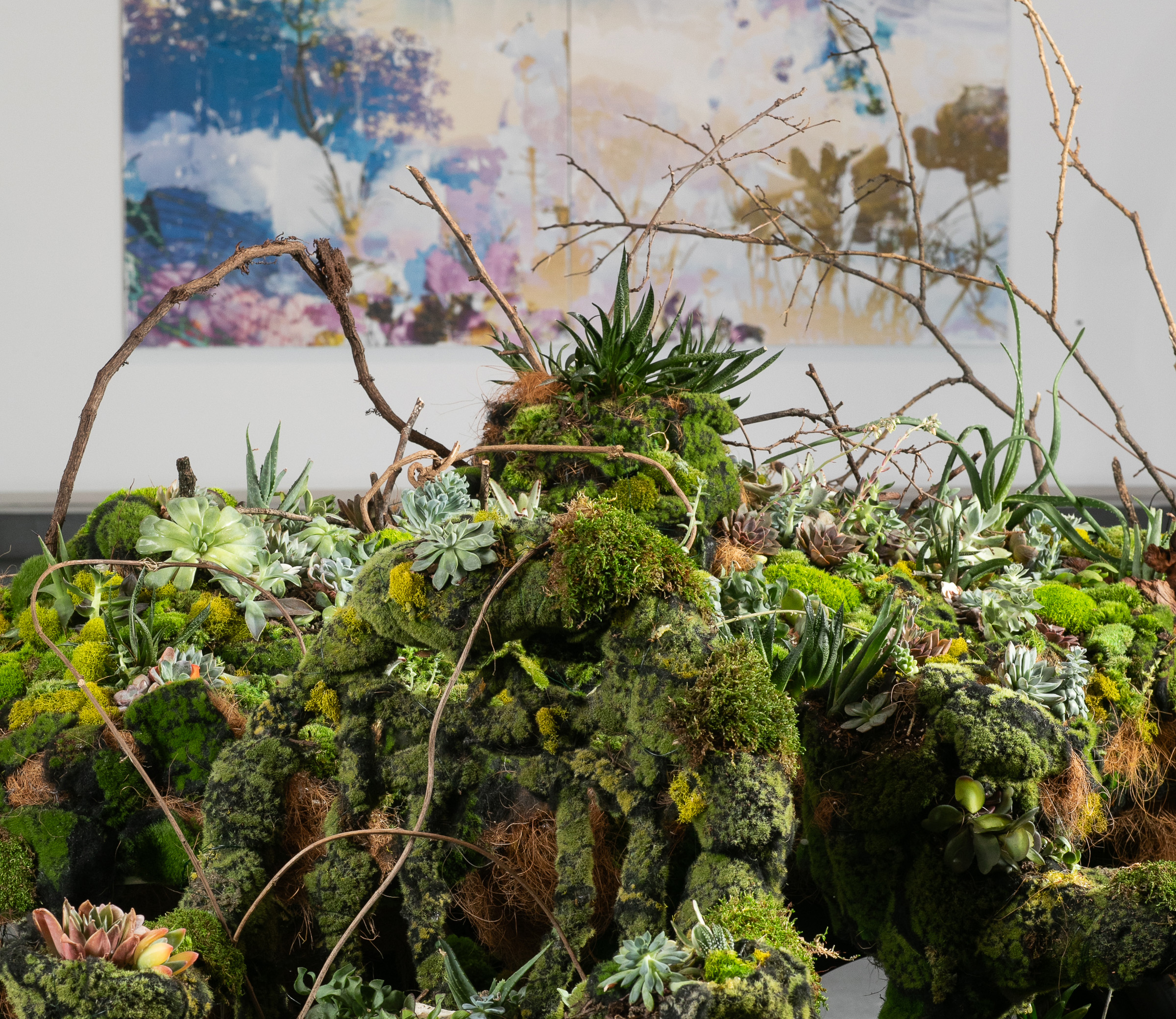Whitehot Magazine
December 2025
"The Best Art In The World"
"The Best Art In The World"
December 2025
Natalie Collette Wood: Nesting Interview
 Nesting Installation at Sugar Hill Children’s Museum, New York, NY 2025, Mixed media, Dimensions variable
Nesting Installation at Sugar Hill Children’s Museum, New York, NY 2025, Mixed media, Dimensions variable
Natalie Collette Wood: Nesting
Curated by Jesse Bandler Firestone
By NOAH BECKER July 4, 2025
Noah Becker: What role did your experience of pregnancy play in shaping the vision and materials for Nesting, and how did it influence your approach to space and storytelling?
Natalie Collette Wood: My recent pregnancy shaped the entire vision of Nesting, largely because its timing aligned so closely with my residency at Sugar Hill Children’s Museum. I interviewed for the residency just a week after finding out I was pregnant, and now, as the show opens, my son is six months old. That arc—of anticipation, transformation, and preparing to nurture a new life became the emotional framework for the work.
As I began the residency, I was confronting big questions: How would we raise two children in the city? How would I continue making art? What would change, and what would remain? What type of world do I want my children to grow within? The term nesting is often used to describe the intense energy surge during the third trimester to clean, organize, and prepare for birth. But for me, it also became a metaphor for a deeper creative and spatial instinct—to build, protect, and imagine a future.
 Garden Fossils, 2025, Inkjet image transfer and gesso on canvas, 72 x 60 inches
Garden Fossils, 2025, Inkjet image transfer and gesso on canvas, 72 x 60 inches
My practice has always explored the relationship between home, nature, and the urban environment, but this time I started researching how different species prepare for birth and make space. I began building my own nests—twisting, tying, and wrapping natural materials like branches and moss. Into these, I wove digitally printed fabrics made from my collages, fragments of imagined landscapes and constructed memories. In many ways, the slips between the imagined and real mirrored the emotional landscape I was sitting within - the real and the possible became integrated in the future visions for my child. My newest sculptures, part of Ariel Nest, hang from the ceiling, suspended and delicate, almost like mobiles above a crib - this narrative woven with the same sense of fragility, suspense, unpredictability, and daydreaming I felt during pregnancy.
The exhibition’s Curator, Jesse Bandler Firestone, honed in on the theatrical elements of the sculptures and positioned the five new paintings like a backdrop, or a sunset to the sculptures—a psychedelic atmosphere that fills the space, fading in and out of focus much like memory and visions. They create a soft, glowing hum to the physical structures. Together, the works became a way for me to process transition, uncertainty, and the deeply biological impulse to make space for new life.
 Nesting Installation at Sugar Hill Children’s Museum, New York, NY 2025, Mixed media, Dimensions variable
Nesting Installation at Sugar Hill Children’s Museum, New York, NY 2025, Mixed media, Dimensions variable
NB: Your work often brings together the natural and the domestic—moss, flowers, found objects, even jazz history. How do you decide what belongs in a particular installation or painting?
NCW: Each body of work I create is grounded in place. I begin by immersing myself in the textures and histories of the environment I’m working within. For this residency, rooted in Harlem, I felt called to honor the neighborhood’s rich legacy of music, art, and cultural resilience.
One day, while searching online, I typed “Harlem Nest” and stumbled upon The Nest, a historic jazz club that once thrived on Swing Street. In the 1920s and ’30s, it served as a sanctuary for Black expression, where legends like Duke Ellington, Cab Calloway, and Billie Holiday performed. Dancers wore bird-inspired costumes adorned with feathers and put on extravagant shows. I was instantly drawn in. My mother had danced at the Moulin Rouge, and my grandmother was a seamstress. I grew up surrounded by sequins, fringe, and stories of transformation through performance. The imagery and materials of The Nest felt deeply familiar. Though The Nest in its original form is now closed, in its place is The Nest Health Center which provides access to quality HIV/AIDS care. I was struck by the layers embedded within the show’s namesake and its ongoing relationship to Harlem.
 Nesting Installation at Sugar Hill Children’s Museum, New York, NY 2025, Mixed media, Dimensions variable
Nesting Installation at Sugar Hill Children’s Museum, New York, NY 2025, Mixed media, Dimensions variable
This connection shaped the visual language of the show. I began to meditate on what my idea of “The Nest” might be - reimagined as a futuristic forest, an ecological dreamscape pulsing with sound, movement, care, and memory. The paintings layer imagery of jazz clubs, the Bailey House, and domestic interiors with oversized botanical forms and larger than life-size flowers. These collaged references are historical and personal, natural and constructed, and allow me to build worlds that feel both grounded and surreal.
Every material I use—whether moss, fabric, printed collage, or sound is selected for its physical properties and emotional and symbolic resonance. I’m always asking: How does this material or object carry a memory, tell a story, or make a space feel more alive?
NB: In Nesting, the idea of shelter seems both physical and emotional. What does the concept of a “nest” mean to you at this moment in your life and practice?
NCW: The idea of a nest has really evolved for me over the course of this project. When I began the residency, I was focused on the physical side of it, building an actual space in our home to welcome a child, and creating physical objects for the exhibition. I was thinking about protection, structure, and the basic need to make space for something new.
But as the residency progressed, and I spent more time at Sugar Hill, my thinking shifted. I began to see nests not just as physical shelters, but as social and emotional ones, spaces where people come together, improvise, and feel safe being themselves.
Similarly to how Ariel Nest functions like a system of hanging satellites, I think of a nest as the orbit of my everyday life. Of course, it includes my home especially with two small children but it also includes my studio, and the places I return to often. It’s my neighbor next door and the people I cross paths with regularly. A nest is not a place, it's a network of relationships. It’s where care happens.That shift from structure to connection has changed the way I see both my art practice and my life.
 The Nest on Swing Street, Inkjet image transfer and gesso on canvas, 60 x 72 inches
The Nest on Swing Street, Inkjet image transfer and gesso on canvas, 60 x 72 inches
NB: You reference The Nest, the Harlem jazz club, as an influence. How does music and performance history inform your visual work, particularly in this exhibition?
NCW: Music, and especially performance, has always been a quiet influence in my work, but in this exhibition it moved to the forefront. As I planned the paintings and sculptures, I approached them almost like improvisations. Each mark, layer, or material prompted the next, creating a kind of visual call and response. It reminded me of how jazz works: reactive, fluid, present, and full of feeling.
That improvisational spirit carried into the sculptural process, where each addition or subtraction shaped the next move. The last piece I created for the show was Botanical Syncopation, a soundscape that I created with Pierre Defendini that weaves together bird calls, sparrows, loons, owls with jazz trumpet riffs. I wanted the sound to mirror the rhythm of the visual work and create a dialogue across the space. It became the thread that ties everything together, a subtle nod to The Nest jazz club, but also a reflection on how sound, movement, and visual form can all become ways of building a kind of shelter.
 Nesting Installation at Sugar Hill Children’s Museum, New York, NY 2025, Mixed media, Dimensions variable
Nesting Installation at Sugar Hill Children’s Museum, New York, NY 2025, Mixed media, Dimensions variable
NB: Much of your practice involves found and ephemeral materials. How do you think about permanence versus impermanence in the context of both ecology and memory?
NCW: To me, permanence and impermanence are deeply intertwined. I’m drawn to materials that change over time plants, moss, and found objects because they mirror the way memory works. A piece like Swallowed By Nature is never the same twice. Sometimes things have bloomed, other times they’ve wilted or decayed. That transformation is part of the work.
There’s a physical feeling I get when I encounter those changes almost like the feeling of recalling a memory. A memory can fade, shift, or suddenly take on new meaning depending on where you are in life. I think of impermanence not as something to resist, but as something to embrace. It’s a reminder that nothing is fixed not in nature, not in us and that’s where possibility lives.
 Ariel Nest, 2025, Mixed media, Dimensions variable
Ariel Nest, 2025, Mixed media, Dimensions variable
NB: As Nesting is your first museum solo show, how has working within the Sugar Hill Museum’s community—particularly its focus on children and storytelling—shaped the final form of the exhibition?
NCW: For years I was the Deputy Director at Bronx Children’s Museum. I love working with children—it’s one of the main reasons I applied to this residency. There’s something so fresh, honest, and joyful about a classroom that’s truly in the zone. The Sugar Hill community is incredibly special and embraces that spirit wholeheartedly. They’ve created their own kind of nest—one that beautifully weaves together affordable housing, culture, and education in a way that feels deeply interconnected. The museum is part of daily life here, and you can see its impact on the children.
The museum’s commitment to activating exhibitions through storytelling and performance deeply influenced my approach. I created custom costumes, scarves, and a library of props for children and caregivers to explore together. I also designed a dedicated space at the back of the exhibition where children can build, weave, and create their own nests using soft sculptures. Since becoming a parent, I’ve come to understand how children experience the world in such a tactile, embodied way. I wanted to offer a space where they could play, relax, and find joy together. WM
Sugar Hill Children’s Museum of Art and Storytelling
Natalie Collette Wood: Nesting
2025 Artist in Residence Solo Exhibition
Curated by Jesse Bandler Firestone
On view through August 17, 2025

Noah Becker
Noah Becker is an artist and the publisher and founding editor of Whitehot Magazine. He shows his paintings internationally at museums and galleries. Becker also plays jazz saxophone. Becker's writing has appeared in The Guardian, VICE, Garage, Art in America, Interview Magazine, Canadian Art and the Huffington Post. He has written texts for major artist monographs published by Rizzoli and Hatje Cantz. Becker directed the New York art documentary New York is Now (2010). Becker's new album of original music "Mode For Noah" was released in 2023.
Becker's 386 page hardcover book "20 Years of Noah Becker's Whitehot Magazine of Contemporary Art" drops Aug 8, 2025 globally on Anthem Press.
Noah Becker on Instagram / Noah Becker Paintings / Noah Becker Music / Email: noah@whitehotmagazine.com
view all articles from this author







